Flare, an EVM-based Layer 1 blockchain with native interoperability protocols, launched a demonstration of trustlessly buying an NFT on Flare utilizing the token of a special blockchain. The NFT was bought on Flare’s canary community, Songbird, straight by paying with tokens on different blockchains, specifically the DOGE and XRP tokens.
Two core interoperability protocols of Flare enabled the operations carried out within the NFT demo. These two protocols present the basic construction for builders to construct new functions. For example, in a latest partnership, Flare and the ed-tech start-up Uppercent got down to create a secondary on-line course market powered by these elementary protocols.
Time Sequence Oracle and State Connector
The primary one is the Flare Time Sequence Oracle (FTSO), which delivers decentralized knowledge feeds for functions that run on Flare. This protocol presently consists of cryptocurrency costs, however it could embrace any time sequence knowledge, for instance, non-crypto costs and climate knowledge.
At current, FTSO acquires knowledge in three-minute intervals from round 90 totally different unbiased knowledge suppliers. Within the case of the NFT buying demo, FTSO helped purchase the corresponding reside worth of the NFT within the different blockchain.
The second protocol is the State Connector, which retrieves knowledge from different blockchains and in addition offchain knowledge from the web. This knowledge can straight be used securely and trustlessly with EVM-based good contracts operating on the Flare community.
Within the demo, State Connector was used to show the transaction was confirmed on Flare’s chain and to confirm the inclusion of the right cost knowledge.
Hugo Philion, Flare CEO and co-founder, mentioned, “This demo highlights Flare’s ability to provide more types of secure, decentralized data on-chain in order to power new functionality and potential use cases for the industry. The NFT demo is one example of the web3 utility Flare can unlock for legacy tokens, enabling them to be used trustlessly in dapps on the network. We are excited to see what other applications engineers can develop, harnessing the capabilities of Flare’s native interoperability protocols.”
Why on Songbird?
The demo NFTs had been minted on the Songbird chain, a canary community. Canary networks are used to check a brand new characteristic earlier than the precise implementation. As such, the aim of the Songbird is to check Flare know-how in a reside setting earlier than deploying it on the mainnet.
How did the demo run?
An NFT dapp on Flare was used to carry out the demo. NFTs within the demo had been customary ERC-721 tokens minted on the Songbird and bought on exterior chains. The dapp known as FTSO for bridging NFT costs between the XRP ledger and Flare.
After that, a contract name is used to order NFT minting for getting extra knowledge like cost deal with, quantity, and a reference to determine the cost with that specific NFT. As soon as the cost was carried out outdoors of Flare, State Connector was used to confirm it in a trustless and decentralized method and join it with the NFT contract on Songbird.
Since Flare is EVM-based, any appropriate pockets would work, although Bifrost pockets was used within the demo, because it natively helps Flare. As soon as the pockets is linked with the NFT dapp, it’s attainable to set the minting worth within the goal forex, which within the demo case was DOGE, as a result of the dapp mechanically calculates the NFT worth.
This demonstration is essential because it reveals the power to purchase an NFT with a token from one other blockchain in a safe, decentralized, and trustless method. Within the Songbird workflow, a number of steps had been obligatory to hold out and ensure the transactions. Within the demo video, Hugo Philion mentions that the ultimate implementation would require the demonstrated workflow to be built-in with a front-end product, similar to an NFT market or a crypto pockets. Consequently, customers will solely want a number of steps for transactions.


